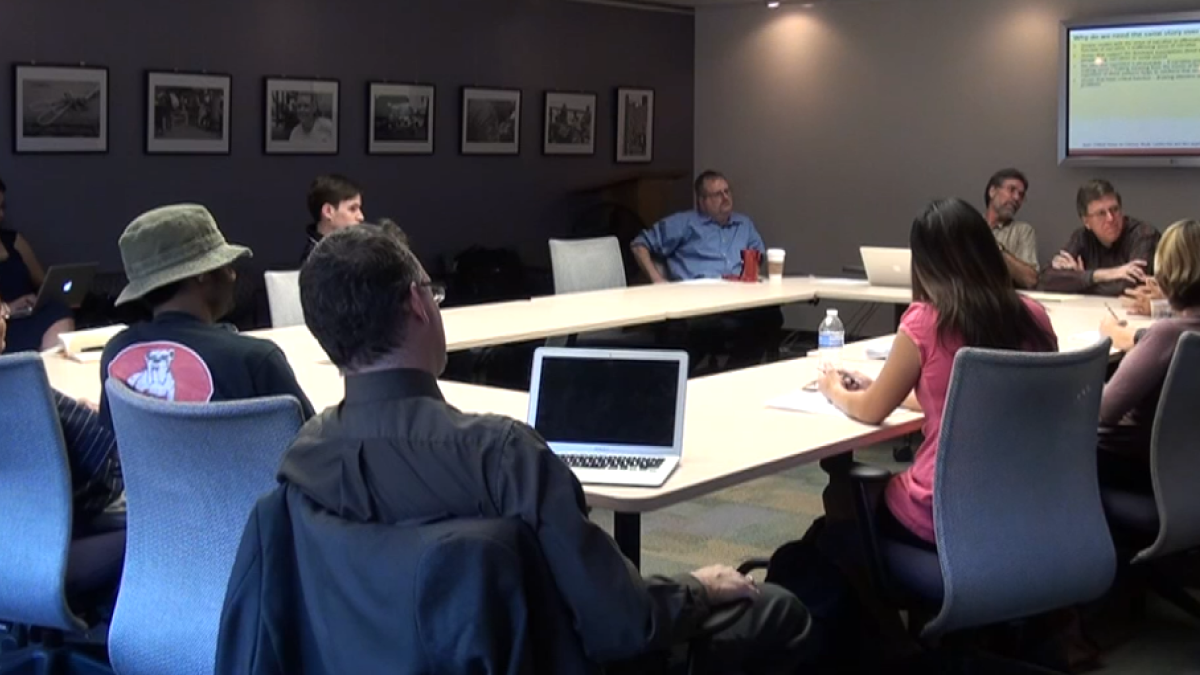ASU groups seek to collaborate, construct interdisciplinary energy narrative

What does an energy narrative look like? Why do we need an energy narrative, and how do we tell that story? These are just some of the many questions ASU LightWorks, Project Humanities, and Energy, Ethics, Society, and Policy (EESP) hope to answer through a variety of collaborative interactions.
EESP is an interdisciplinary research community where graduate students at ASU have opportunities to hear from a collection of speakers, including policy makers, industry representatives, faculty, researchers, and community leaders to gain a more holistic perspective of the social implications of energy system transformations. There is a unique seminar element to the group that provides students with direct access to a variety of diverse speakers from a multitude of backgrounds and perspectives. The most recent course theme brings together students and faculty from ASU to discuss “narrative” and how the humanities are intertwined throughout the energy space.
Project Humanities is a university-wide initiative, with the expressed goal of showing the interactions among humanities and other areas of scholarship and human endeavor. It examines place as the interactive space where humanity defines itself through stories and ritual, through exchanges that transcend beyond literal notions of site, and through its involvement in the many challenges that face society in its creation and sustainment of that place. The initiative seeks to share humanities-centered activities and programs that make visible the far-reaching impact of humanist thinking and practice.
ASU LightWorks is a multidisciplinary university initiative that pulls light-inspired research under one strategic framework in an effort to leverage ASU’s unique strengths, particularly in renewable energy fields including artificial photosynthesis, biofuels, and next-generation photovoltaics. LightWorks is actively building upon an energy education portfolio for the university, including the EESP seminar course. Gary Dirks, Director of LightWorks, has expressed a need for an energy narrative that shows us what stories are already being told, what our different futures could look like, and how to understand the power of narrative as an analytical tool for evaluating our energy choices.
Each of these initiatives finds intersection in the EESP seminar because of ASU’s transdisciplinary approach to research and the focus of the humanities at the university. Conversation at the EESP seminar included the structure and purpose of narrative as a way of reading ourselves and our communities through our various social constructs.
During the discussion Clark Miller, associate director of Consortium for Science, Policy and Outcomes (CSPO), said, “It seems to me that if you’re talking about a complex system that is embedded in human lives in a wide range of different ways then the best approach to narrative may not necessarily be to try to construct… a single master narrative, but rather to tell the story of solar energy…through a multiplicity of narratives and stories that capture the richer and deeper realities of the ways in which these technologies interact with our complicated lives.”
Peter Turchi, professor of English, added that if we’re creating a story to bring about social change then, “we’ve chosen one of these narratives and we’re saying this is the way we ought to go. Let’s say we're promoting solar energy. We have to make that argument in different ways…but we wouldn't also say ‘Maybe not solar energy.’ Whatever change we endorse, we need to choose one narrative and privilege it.”
Dan Gilfillan, associate professor of German Studies and the acting director of the Institute for Humanities Research, noted that while the master narrative can essentially stay the same, there are ways in which it may be slightly skewed to speak to each audience group in terms of culture, ethnicity, and socio-economic backgrounds. He gave English Professor Ayanna Thompson’s work in “color blind casting” of Shakespearean drama as an example of using a master narrative that successfully speaks to wide audiences through minor adjustments.
The narrative theme will continue in the next EESP session with the topic as “Narrative and Social Change” on Nov. 19, which will provide more context into how the humanities are interwoven with the energy problems we face today, how to better incorporate the humanities into the energy discussion, and how to continue to build narratives around renewable energy. Speakers will include Neal Lester, director of Project Humanities and professor of English, and Ron Broglio, associate professor of English.
The Consortium for Science, Policy and Outcomes (CSPO), the Institute for Humanities Research and the Department of English are all research units within ASU's College of Liberal Arts and Sciences.
Written by Sydney Lines, management intern, ASU LightWorks
Media contact: